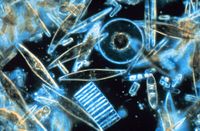
Photo from wikipedia
Understanding of the molecular responses underpinning diatom responses to ocean acidification is fundamental for predicting how important primary producers will be shaped by the continuous rise in atmospheric CO2. In… Click to show full abstract
Understanding of the molecular responses underpinning diatom responses to ocean acidification is fundamental for predicting how important primary producers will be shaped by the continuous rise in atmospheric CO2. In this study, we have analyzed global transcriptomic changes of the model diatom Phaeodactylum tricornutum following growth for 15 generations in elevated pCO2 by strand-specific RNA sequencing (ssRNA-seq). Our results indicate that no significant effects of elevated pCO2 and associated carbonate chemistry changes on the physiological performance of the cells were observed after 15 generations whereas the expression of genes encoding histones and other genes involved in chromatin structure were significantly down-regulated, while the expression of transposable elements (TEs) and genes encoding histone acetylation enzymes were significantly up-regulated. Furthermore, we identified a series of long non-protein coding RNAs (lncRNAs) specifically responsive to elevated pCO2, suggesting putative regulatory roles for these largely uncharacterized genome components. Taken together, our integrative analyses reveal that epigenetic elements such as TEs, histone modifications and lncRNAs may have important roles in the acclimation of diatoms to elevated pCO2 over short time scales and thus may influence longer term adaptive processes in response to progressive ocean acidification.
Journal Title: Frontiers in Microbiology
Year Published: 2019
Link to full text (if available)
Share on Social Media: Sign Up to like & get
recommendations!